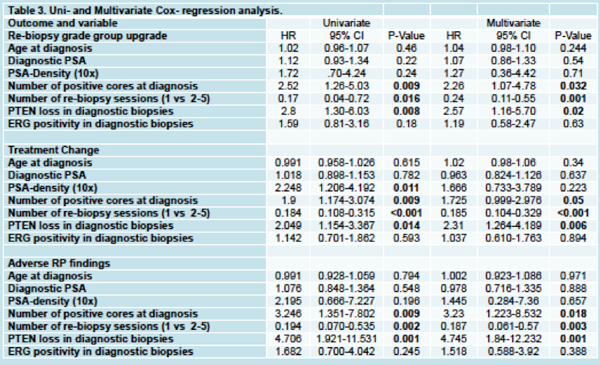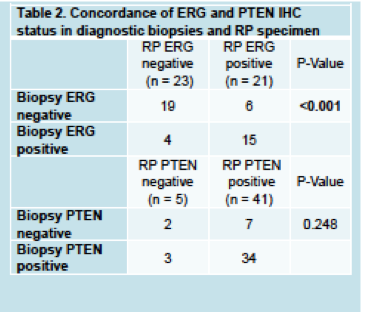The authors had access to 203 of the 231 patients enrolled in the PRIAS trial (launched 2007). Of these patients, 57 patients (24.7%) underwent RP and the RP pathology was analyzed in conjunction to biopsy tissue. DBx containing PC and the RP sections were stained with ERG antibody (clone EPR 3864, Abcam) and a PTEN antibody (clone D4.3 XP, Cell Signaling Technology). ERG and PTEN were then scored as either negative or positive. Biomarker status was analyzed in DBx with comparison to rebiopsy Gleason upgrade, treatment change and adverse findings in surgical specimens. In addition, concordance of biomarker status in DBx and RP specimen was evaluated.
Demographics of the groups are listed below:

In univariate and multivariate cox regression analysis, only the number of positive cores in the diagnostic biopsy, the number re-biopsy sessions and PTEN status at diagnosis were significantly associated with re-biopsy Gleason upgrade, treatment change and adverse histopathological findings in RP specimens (Table 3).

Concordance of ERG and PTEN between dBx and RP specimen are highlighted in Table 2.

In Kaplan Meier analysis, PTEN loss was significantly associated with a shorter time to
Gleason upgrade or treatment change (P = 0.006). In Gray’s competing risk analysis, PTEN status was associated with Gleason upgrade AS discontinuation (P = 0.029).
Ultimately, it would seem that while ERG status correlated the best between dBx and RP specimen, it was PTEN loss that was more clinically relevant and predictive of progression and treatment change. However, the discordance between dBx and RP is a little disconcerting and not easily explained. Further work is needed in this area to determine if PTEN is truly a useful biomarker.
Speaker(s): Andrew Erickson
Co-Authors: Lokman U., Vasarainen H., Mirtti T., Rannikko A.
Written By: Thenappan Chandrasekar, MD, Clinical Fellow, University of Toronto
Twitter: @tchandra_uromd
at the #EAU17 - March 24-28, 2017- London, England


